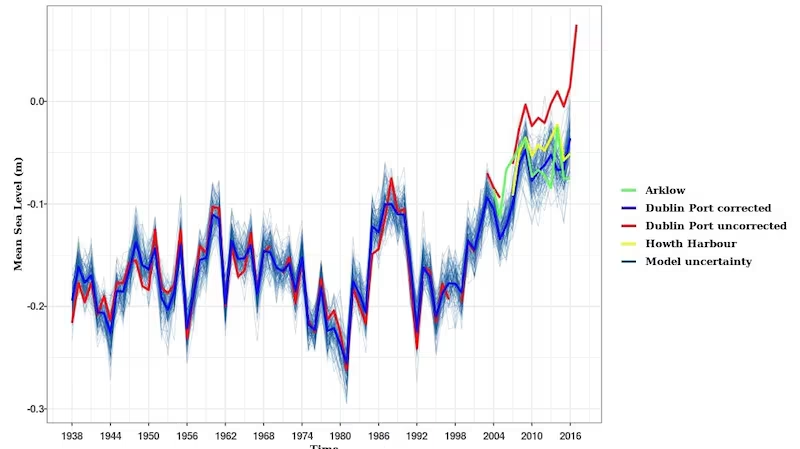An analysis of trends in Dublin Bay over eight decades has confirmed the sea-level is rising faster than expected - at approximately double the rate of global sea-level rise.
The recent trends for the capital are above what climate change models have predicted, leading scientists at Maynooth University to conclude local factors are contributing to the change.
They warn these will need to be identified, to ensure Dublin is adequately prepared for inevitable sea-level rise this century and beyond due to global warming and melting ice sheets.
The latest research led by the Hamilton Institute and ICARUS Climate Research Centre has generated an updated sea level dataset for Dublin stretching from 1938 and to 2016. It confirms the capital is experiencing a similar trend to Cork.
Overall, the trend shown in the data corresponds to an estimated sea-level rise between 1953 and 2016 of 1.1 millimetres per year in Dublin, according to their research published in Ocean Science this week.

"Fluctuations are identified with sea levels rising from 1982 to 1988, before falling from 1989 to 1996, and once again rising from 1997 to 2016 at a rate of 7 millimetres per year. This recent sea level rise is faster than expected at approximately double the rate of global sea-level rise," said Amin Shoari Nejad, lead author of the study – a PhD student at the Hamilton Institute.
“Overall sea level rise is in line with expected trends but large multidecadal variability has led to higher rates of rise in recent years.”
The researchers compared sea level records for Dublin Port, gauges at Arklow and Howth harbours, and international datasets from the UK and France.
“If you look at too short a timeframe, the fluctuations over decades could impact estimates of trends. But this research has taken a longer view and what we are most confident about from looking at the stretch of years is the overall rise,” said Dr Gerard McCarthy of ICARUS.
Flooding risk
Most Irish cities are coastal with 40 per cent of the population living within 5km of the coast. Recent flooding reinforces the need to understand how sea levels are changing around Ireland with Cork, Galway, Dublin and Limerick being most vulnerable.
Future sea levels around the Irish coast depend on a combination of global and local factors, the Maynooth team said. Global sea level rise is driven by climate change with up to 1m of sea level rise predicted by 2150, if greenhouse gas reductions fall short of targets – this is based on climate models applying the most-likely scenario based on current data.
With sea-level rise in Dublin and Cork greater than expected from climate change alone, it points to local exacerbating factors that need to be understood, said Dr McCarthy.
Dublin record
Sea level rise in Dublin should be the easiest case to describe as it is the longest record of sea level in the Republic, he said.
The Dublin record, however, had in recent years been viewed “a little dubiously” due to questions about data quality. In response to this, the Dublin record was calibrated by adjusting biased high water measurements that affect the overall calculation of average sea level, in light of better gauges that are now available.
Confirmation of high rates of sea level rise, which are already built into Dublin climate action plan, does not yet unearth the cause of this rapid rise, he underlined. A partial reason may be reclaimed land in Dublin port and resulting compaction of sediments, he added.
A previous 2021 report concluded Cork was also experiencing higher than expected sea-level rise - again highlighting the need to identify what are the local factors are causing this. This could be due to local subsidence in Cork harbour due to manmade or natural factors, or “a hangover from the last Ice Age”, Dr McCarthy said.
“Understanding this is key to adjust future climate projections of sea-level rise for use in local adaptation.”
The researchers at Maynooth, in collaboration with colleagues at UCC and DCU, are continuing to explore the reasons behind such fluctuations.
The latest research was carried out in collaboration with Prof Andrew Parnell at the Hamilton Institute; Dr Brian Kelleher of DCU School of Chemical Sciences, and Prof Robert Devoy of UCC Department of Geography, Prof Peter Thorne and Alice Green of ICARUS.









